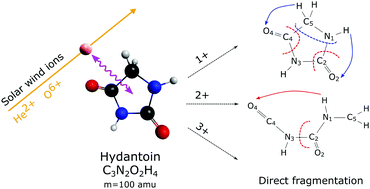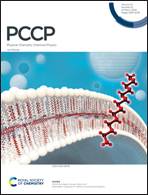Interaction of hydantoin with solar wind minority ions: O6+ and He2+
Abstract
The laboratory study of prebiotic molecules interacting with solar wind ions is important to understand their role in the emergence of life in the complex context of the astrochemistry of circumstellar environments. In this work, we present the first study of the interaction of hydantoin (C3N2O2H4, 100 a.m.u.) with solar wind minority multi-charged ions: O6+ at 30 keV and He2+ at 8 keV. The fragmentation mass spectra as well as correlation maps resulting from the interaction are presented and discussed in this paper. Prompt and delayed dissociations from metastable states of the ionized molecule have been observed and the corresponding lifetimes measured. Experimental results are completed by quantum Density Functional Theory (DFT) calculations for energies, structures and dynamics (Internal Reaction Coordinates and Dynamic Reaction Coordinates) of the molecule for its different reachable charge states and the major observed fragmentation pathways. These calculations show that the molecule can only support two charges before spontaneously dissociating in agreement with the experimental observations. Calculations also demonstrate that hydantoin's ring opens after double ionization of the molecule which may enhance its reactivity in the background of biological molecule formation in a cirmcumstellar environment. For the major experimentally observed fragmentations (like 44 a.m.u./56 a.m.u. dissociation), Internal Reaction Coordinate (IRC) calculations were performed pointing out for example the important role of hydrogen transfer in the fragmentation processes.



 Please wait while we load your content...
Please wait while we load your content...